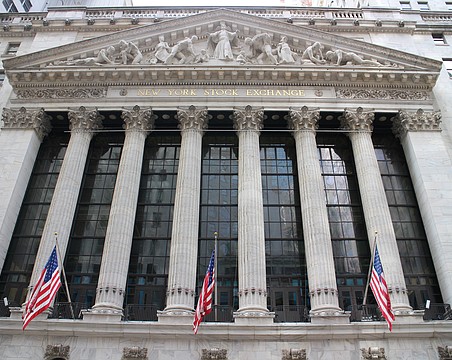The market, which is in a bull trend, is not priced for gains. It's already the second-most expensive market in history. Rather, the market is postured to hand investors heavy losses.
Here are some of the underpinnings of this economy that could affect the ability of the market to increase further in value:
1. The market is strong because of the $600 billion the federal government printed to stimulate the economy, called “QE2,” this year. In June, the last of the QE2 funds Congress authorized will be spent. At that point, it is likely the market will sell off. QE2 funds go to the banks, which lend the money to brokers. The government hopes that when QE2 is terminated in June, the market — and the economy — will be able to sustain themselves. That is unlikely. Thirty percent of current federal government expenditures are borrowed, and without the borrowed funds, the government cannot continue to operate. Look for more government borrowing. More debt creates additional financial burdens, which this economy is already incapable of handling.
2. Roughly 40% of government expenditures are debt. We are already at 30%. In the last 20 years, Brazil, Turkey and Russia have inflated away their debt. That would be nice but difficult for the U.S. to do, because the dollar is the world's reserve currency.
3. Social Security currently represents 25% of federal government expenditures. Fifty percent of government expenditures are indexed, so inflation will continue until Congress changes the law. Social Security, Medicare and Medicaid will cause 72% of the increase in government expenditures through 2020 (Congressional Budget Office), and that's absurdly understated.
4. Real GDP growth in the last 100 years in this country has been just more than 3% per annum. Growth is expected to be less than 2% annually over the next 10 years. Debt requirements alone will exceed cash created from such growth.
5. Japan's problems today are the result of its large debt build-up in the 1980s. The Japanese economy has been flat ever since. Its stock market trades at less than 1/3 of what it did in 1989. The U.S. government is experiencing the same problems today managing debt that Japan has had for the last 20 years.
6. Inflation statistics are false. Food and energy are not part of the Consumer Price Index. Anybody who has filled his gas tank or been to the grocery knows that inflation is already here. The following are some differences in prices from two years ago: Gas is up 70%, gold is up 61%, corn is up 78%, soybeans are up 42% and sugar is up 165%. These commodity price increases spill over into the cost of everything. They create the real core of our inflation, which is not accounted for in the CPI!
7. Residential real estate rentals are anticipated to increase 15% by the end of 2012. The vacancy rate is forecast to be less than 5% by then. The pressure on rentals continues because of people vacating homes, people coming into the employment world and graduating from schools and those people who are not credit-worthy enough to own a house. Housing costs are likely to increase rapidly, like food and fuel have lately.
8. The PPI (Producer Price Index) is increasing at the rate of 20% annually, as compared to a 5.8% increase last year. This indicates that inflation is heating up. How can government statistics show us we are only experiencing 2.4% annual inflation?
9. The U.S. dollar is now the world's biggest bubble following our bond-market bubble, stock-market bubble, high-tech bubble and the real estate bubble, all created by the federal government and the always-complicit Federal Reserve System. As with the stock market, there are more reasons for the dollar to continue sinking than for the dollar to stabilize.
10. Last week it was announced that the Federal Reserve Bank's profits rose sharply to $94 billion last year. The amazing thing is that the public accepted that fabrication. Here's how it works: The Federal Reserve prints money with a computer entry and “loans” it to the federal government, which pays interest back to the Fed for the use of the funds. Not one lick of work has been expended for all of this cash — it's simply magical, like us printing our own money when we run out of cash. And it's highly inflationary.
11. Charles Dow, founder of the Wall Street Journal, would counsel to never invest in a stock that paid less than a 3.5% dividend yield. The dividend yield now on the Dow stocks is 2.4%. Should the market sell at a 3.5% yield, instead of a 2.4% yield, the DJIA would be 8,400 points instead of 12,200 points. In severe market downturns, yields reach 6% (1970s and 1980s). A 6% yield would move the Dow to 4,900 points. Just the historical average Dow yield of 4.3% would move the market to 6,800 points, 44% lower than it is now.
12. We need 10 million jobs to get back to 5% unemployment, the rate we had before all of this began. Creating 1.5 million jobs a year is necessary just to absorb young people coming into the labor market. If we begin to produce jobs at the rate of 300,000 a month, the amount in the late 1990s during the strongest job growth in our history, it would take more than four years to dig us out of this hole. (The above paragraph was published in an April 2010 Market Watch article.)
Conclusion
The cautious investor would be wise to maintain liquidity and build cash. Patience will pay great dividends. Future opportunities are likely to be greater than existing opportunities for investors with cash. There is a large amount of sorting out in the economy yet to occur. The most difficult thing to do is to be patient, which reminds us of the old saying: “Patience is a virtue. Catch it if you can. Seldom found in woman and never found in man!”
To justify these price-earnings ratios, real growth in our economy would need to exceed 5% annually for an extended period of time. Even our historical growth rate of 3% annually will not get us back to an economy that can justify these stock-market heights. One knows they have problems when it's necessary to borrow money simply to pay interest on debt.
Until the many problems of this economy are better addressed than the Congress-proposed $50 billion to $100 billion in spending cuts, the taxation and interest payments required for government expenditures will require more than 100% of our country's annual income for years to come. Government requirements for cash in our economy are in conflict with economic growth, which must have a negative effect upon the stock markets, unless rectified.
Caveat emptor.





